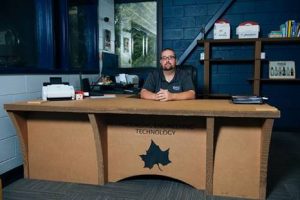Subscriber Benefit
As a subscriber you can listen to articles at work, in the car, or while you work out. Subscribe NowMost shoppers are familiar with at least some of the technology involved in getting packages from Point A to Point B. Amazon has played a big part in bringing that to the fore.
But fewer know about the technology that goes into designing and developing the packaging itself. And with more products bought online and shipped, the packaging of those goods is becoming increasingly important.
Indiana State University is at the forefront of the increasingly complicated and important world of packaging. It’s one of seven colleges in the U.S. to offer a four-year degree in package engineering technology.
And the demand for those graduates is skyrocketing, according to school officials.

“We have 100% placement among our graduates,” said Brian James, an instructor and program coordinator for ISU’s package engineering technology program. “We have so many unfilled positions, it’s crazy.”
Starting salaries for students graduating from the ISU program are between $50,000 and $75,000, James said. “They’re able to increase their salaries pretty quickly,” he told IBJ.
Recent graduates have taken jobs at Caterpillar, Carrier Group, Cook Group, Zimmer, Baxter pharmaceuticals, Raytheon, Jim Beam, Brown-Forman and Sazerac—the maker of Fireball whisky.
There are essentially two levels of packaging—and both have quite a bit of design and development behind them. First, there’s the packaging you see on store shelves and in online store photos. Then there’s the outer packaging that offers further protection as the package travels by plane, train and automobile to the consumer or retailer.
“For years, this industry focused mostly on the packaging on the shelf, and how to use that packaging as a marketing tool to induce sales,” James said. “The rise of companies like Amazon has changed all that. Now we’re focused much more on the structural side of design.”
One key factor for delivery is having boxes that are designed to protect a product but take up as little space as possible and can be easily stacked with other packages.
“The delivery trucks you see on the roads—the ones that seem like they’re everywhere during the holidays—they have a fairly limited capacity,” James said. “It’s important for these logistics businesses to be able to carry as much cargo as possible to ensure timely delivery. How the boxes nest together is extremely important these days.”
Sustainability—making products out of more recyclable materials and fewer materials overall—has also become increasingly important.
“A lot of suppliers really want us to focus on the overall reduction of materials used. But you still have to protect the product in shipping,” James said. “They also want us to focus on designing packages that can be used to ship a variety of different goods. This brings their costs down.”
The design and production of packaging materials has gone from a manual to a primarily digital process in the last five to 10 years, and ISU has been on the leading edge of those technological advancements, James said.
The design of packaging has to conform to a bevy of national and international standards. And ISU students design packaging and test it on machines that take their creations and jostle, drop and compress them.
Businesses are taking notice of the work being done at Indiana State. The program recently received a $1.2 million in-kind gift from Esko, which makes software commonly used in the industry.
The Indiana Packaging Research and Development Center at ISU also uses virtual reality technology to design packaging that will be effective in the marketplace. Virtual reality technology allows designers to make sure a package performs the way it’s designed to without the cost of making a real prototype, James explained.
The department also has added a digital press and cutting table to help with design and development training.
“The new press allows much more complex design with many more elements on the packaging,” James explained. “And the precision is greatly enhanced which is critical these days.
“The packaging industry may seem very basic,” James added, “but it’s becoming a lot more complex and technical as the business world’s demands for packaging material changes and expands. It’s simply not enough these days for a box to merely carry goods. The packaging industry has become a leading force for change.”
Please enable JavaScript to view this content.
